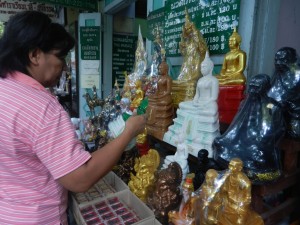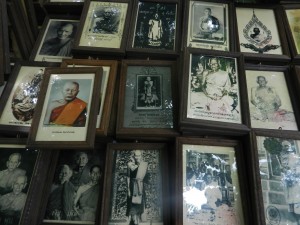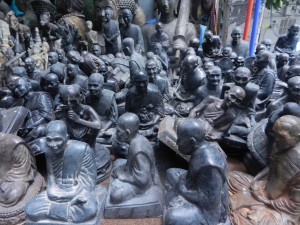Buffalos, monsoons, riverine villages–why have I been writing about so many ancient things lately?
Because the ancient past still lives in Southeast Asia. Modern Bangkok bustles with skyscrapers and shopping malls, but the past thrives right next to them. You can’t reduce Bangkok to any mental category. It’s so full of contradictions that its sheer abundance reflects the ancient landscape of Southeast Asia which the last several posts explored. I spent more time in Bangkok during this journey than in the previous trip, yet I left longing for more.
Bangkok’s amulet market bustles by the Chao Phraya River, from its Grand Palace to the National Museum–it’s next-door to some of Thailand’s most honored institutions.
Most Thai’s follow Theravada Buddhism’s conservative faith.
And thus many amulets are graceful Buddha statues.
Many folks also sell pictures of people revered for spiritual powers. Buyers can display them in their homes and offices for luck.
The volume of goods is huge. So is the variety–it extends far beyond Buddhist conventions.
Hindu gods have honored places too. The elephant-headed god, Ganesha (shown above), is a son of Shiva. Businesspeople in India and Thailand honor him because he can bring wealth.
But the amulet market’s inventory also extends beyond the hoary religions imported from India.
Several people sold phalluses too. Many were inscribed with magical symbols. Some folks buy them and wear them for fertility, prosperity and physical vitality. They meant these things in ancient Rome too, and people used to attach them to the doorways of their homes. But that was 2,000 years ago. Westerners don’t do that anymore–Christianity instructed believers to throw out indecorous pagan customs.
But Thai Buddhism tolerates a lot of customs from the ancient past. People buy different amulets for different needs. The sheer variety of them makes folks feel comfortable–all bases are covered. The abundance of life forms that have thrived along Southeast Asia’s great rivers since ancient times is alive and well in modern Bangkok.








Comments on this entry are closed.